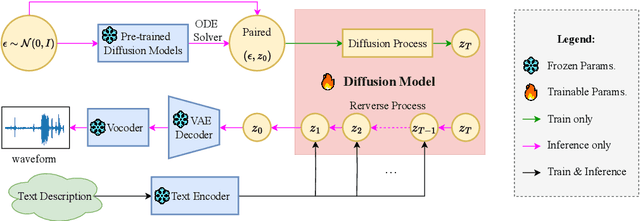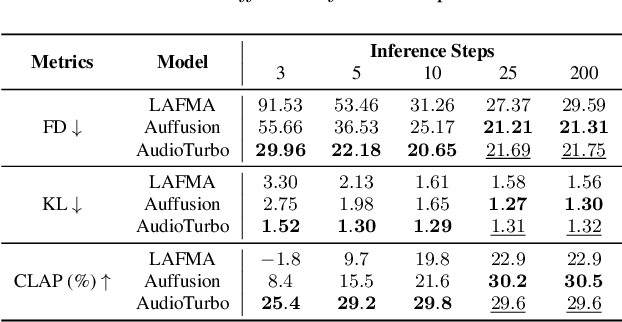Wenwu Wang
RFM-Editing: Rectified Flow Matching for Text-guided Audio Editing
Sep 17, 2025Abstract:Diffusion models have shown remarkable progress in text-to-audio generation. However, text-guided audio editing remains in its early stages. This task focuses on modifying the target content within an audio signal while preserving the rest, thus demanding precise localization and faithful editing according to the text prompt. Existing training-based and zero-shot methods that rely on full-caption or costly optimization often struggle with complex editing or lack practicality. In this work, we propose a novel end-to-end efficient rectified flow matching-based diffusion framework for audio editing, and construct a dataset featuring overlapping multi-event audio to support training and benchmarking in complex scenarios. Experiments show that our model achieves faithful semantic alignment without requiring auxiliary captions or masks, while maintaining competitive editing quality across metrics.
Teacher-Guided Pseudo Supervision and Cross-Modal Alignment for Audio-Visual Video Parsing
Sep 17, 2025Abstract:Weakly-supervised audio-visual video parsing (AVVP) seeks to detect audible, visible, and audio-visual events without temporal annotations. Previous work has emphasized refining global predictions through contrastive or collaborative learning, but neglected stable segment-level supervision and class-aware cross-modal alignment. To address this, we propose two strategies: (1) an exponential moving average (EMA)-guided pseudo supervision framework that generates reliable segment-level masks via adaptive thresholds or top-k selection, offering stable temporal guidance beyond video-level labels; and (2) a class-aware cross-modal agreement (CMA) loss that aligns audio and visual embeddings at reliable segment-class pairs, ensuring consistency across modalities while preserving temporal structure. Evaluations on LLP and UnAV-100 datasets shows that our method achieves state-of-the-art (SOTA) performance across multiple metrics.
Region-Specific Audio Tagging for Spatial Sound
Sep 11, 2025Abstract:Audio tagging aims to label sound events appearing in an audio recording. In this paper, we propose region-specific audio tagging, a new task which labels sound events in a given region for spatial audio recorded by a microphone array. The region can be specified as an angular space or a distance from the microphone. We first study the performance of different combinations of spectral, spatial, and position features. Then we extend state-of-the-art audio tagging systems such as pre-trained audio neural networks (PANNs) and audio spectrogram transformer (AST) to the proposed region-specific audio tagging task. Experimental results on both the simulated and the real datasets show the feasibility of the proposed task and the effectiveness of the proposed method. Further experiments show that incorporating the directional features is beneficial for omnidirectional tagging.
TEn-CATS: Text-Enriched Audio-Visual Video Parsing with Multi-Scale Category-Aware Temporal Graph
Sep 04, 2025Abstract:Audio-Visual Video Parsing (AVVP) task aims to identify event categories and their occurrence times in a given video with weakly supervised labels. Existing methods typically fall into two categories: (i) designing enhanced architectures based on attention mechanism for better temporal modeling, and (ii) generating richer pseudo-labels to compensate for the absence of frame-level annotations. However, the first type methods treat noisy segment-level pseudo labels as reliable supervision and the second type methods let indiscriminate attention spread them across all frames, the initial errors are repeatedly amplified during training. To address this issue, we propose a method that combines the Bi-Directional Text Fusion (BiT) module and Category-Aware Temporal Graph (CATS) module. Specifically, we integrate the strengths and complementarity of the two previous research directions. We first perform semantic injection and dynamic calibration on audio and visual modality features through the BiT module, to locate and purify cleaner and richer semantic cues. Then, we leverage the CATS module for semantic propagation and connection to enable precise semantic information dissemination across time. Experimental results demonstrate that our proposed method achieves state-of-the-art (SOTA) performance in multiple key indicators on two benchmark datasets, LLP and UnAV-100.
AudioTurbo: Fast Text-to-Audio Generation with Rectified Diffusion
May 28, 2025



Abstract:Diffusion models have significantly improved the quality and diversity of audio generation but are hindered by slow inference speed. Rectified flow enhances inference speed by learning straight-line ordinary differential equation (ODE) paths. However, this approach requires training a flow-matching model from scratch and tends to perform suboptimally, or even poorly, at low step counts. To address the limitations of rectified flow while leveraging the advantages of advanced pre-trained diffusion models, this study integrates pre-trained models with the rectified diffusion method to improve the efficiency of text-to-audio (TTA) generation. Specifically, we propose AudioTurbo, which learns first-order ODE paths from deterministic noise sample pairs generated by a pre-trained TTA model. Experiments on the AudioCaps dataset demonstrate that our model, with only 10 sampling steps, outperforms prior models and reduces inference to 3 steps compared to a flow-matching-based acceleration model.
EnvSDD: Benchmarking Environmental Sound Deepfake Detection
May 25, 2025Abstract:Audio generation systems now create very realistic soundscapes that can enhance media production, but also pose potential risks. Several studies have examined deepfakes in speech or singing voice. However, environmental sounds have different characteristics, which may make methods for detecting speech and singing deepfakes less effective for real-world sounds. In addition, existing datasets for environmental sound deepfake detection are limited in scale and audio types. To address this gap, we introduce EnvSDD, the first large-scale curated dataset designed for this task, consisting of 45.25 hours of real and 316.74 hours of fake audio. The test set includes diverse conditions to evaluate the generalizability, such as unseen generation models and unseen datasets. We also propose an audio deepfake detection system, based on a pre-trained audio foundation model. Results on EnvSDD show that our proposed system outperforms the state-of-the-art systems from speech and singing domains.
From Aesthetics to Human Preferences: Comparative Perspectives of Evaluating Text-to-Music Systems
Apr 30, 2025Abstract:Evaluating generative models remains a fundamental challenge, particularly when the goal is to reflect human preferences. In this paper, we use music generation as a case study to investigate the gap between automatic evaluation metrics and human preferences. We conduct comparative experiments across five state-of-the-art music generation approaches, assessing both perceptual quality and distributional similarity to human-composed music. Specifically, we evaluate synthesis music from various perceptual dimensions and examine reference-based metrics such as Mauve Audio Divergence (MAD) and Kernel Audio Distance (KAD). Our findings reveal significant inconsistencies across the different metrics, highlighting the limitation of the current evaluation practice. To support further research, we release a benchmark dataset comprising samples from multiple models. This study provides a broader perspective on the alignment of human preference in generative modeling, advocating for more human-centered evaluation strategies across domains.
Exploring the User Experience of AI-Assisted Sound Searching Systems for Creative Workflows
Apr 22, 2025Abstract:Locating the right sound effect efficiently is an important yet challenging topic for audio production. Most current sound-searching systems rely on pre-annotated audio labels created by humans, which can be time-consuming to produce and prone to inaccuracies, limiting the efficiency of audio production. Following the recent advancement of contrastive language-audio pre-training (CLAP) models, we explore an alternative CLAP-based sound-searching system (CLAP-UI) that does not rely on human annotations. To evaluate the effectiveness of CLAP-UI, we conducted comparative experiments with a widely used sound effect searching platform, the BBC Sound Effect Library. Our study evaluates user performance, cognitive load, and satisfaction through ecologically valid tasks based on professional sound-searching workflows. Our result shows that CLAP-UI demonstrated significantly enhanced productivity and reduced frustration while maintaining comparable cognitive demands. We also qualitatively analyzed the participants' feedback, which offered valuable perspectives on the design of future AI-assisted sound search systems.
Audio-Visual Class-Incremental Learning for Fish Feeding intensity Assessment in Aquaculture
Apr 21, 2025



Abstract:Fish Feeding Intensity Assessment (FFIA) is crucial in industrial aquaculture management. Recent multi-modal approaches have shown promise in improving FFIA robustness and efficiency. However, these methods face significant challenges when adapting to new fish species or environments due to catastrophic forgetting and the lack of suitable datasets. To address these limitations, we first introduce AV-CIL-FFIA, a new dataset comprising 81,932 labelled audio-visual clips capturing feeding intensities across six different fish species in real aquaculture environments. Then, we pioneer audio-visual class incremental learning (CIL) for FFIA and demonstrate through benchmarking on AV-CIL-FFIA that it significantly outperforms single-modality methods. Existing CIL methods rely heavily on historical data. Exemplar-based approaches store raw samples, creating storage challenges, while exemplar-free methods avoid data storage but struggle to distinguish subtle feeding intensity variations across different fish species. To overcome these limitations, we introduce HAIL-FFIA, a novel audio-visual class-incremental learning framework that bridges this gap with a prototype-based approach that achieves exemplar-free efficiency while preserving essential knowledge through compact feature representations. Specifically, HAIL-FFIA employs hierarchical representation learning with a dual-path knowledge preservation mechanism that separates general intensity knowledge from fish-specific characteristics. Additionally, it features a dynamic modality balancing system that adaptively adjusts the importance of audio versus visual information based on feeding behaviour stages. Experimental results show that HAIL-FFIA is superior to SOTA methods on AV-CIL-FFIA, achieving higher accuracy with lower storage needs while effectively mitigating catastrophic forgetting in incremental fish species learning.
DMAGaze: Gaze Estimation Based on Feature Disentanglement and Multi-Scale Attention
Apr 15, 2025Abstract:Gaze estimation, which predicts gaze direction, commonly faces the challenge of interference from complex gaze-irrelevant information in face images. In this work, we propose DMAGaze, a novel gaze estimation framework that exploits information from facial images in three aspects: gaze-relevant global features (disentangled from facial image), local eye features (extracted from cropped eye patch), and head pose estimation features, to improve overall performance. Firstly, we design a new continuous mask-based Disentangler to accurately disentangle gaze-relevant and gaze-irrelevant information in facial images by achieving the dual-branch disentanglement goal through separately reconstructing the eye and non-eye regions. Furthermore, we introduce a new cascaded attention module named Multi-Scale Global Local Attention Module (MS-GLAM). Through a customized cascaded attention structure, it effectively focuses on global and local information at multiple scales, further enhancing the information from the Disentangler. Finally, the global gaze-relevant features disentangled by the upper face branch, combined with head pose and local eye features, are passed through the detection head for high-precision gaze estimation. Our proposed DMAGaze has been extensively validated on two mainstream public datasets, achieving state-of-the-art performance.
 Add to Chrome
Add to Chrome Add to Firefox
Add to Firefox Add to Edge
Add to Edge